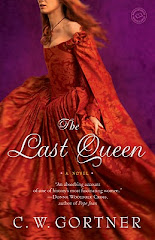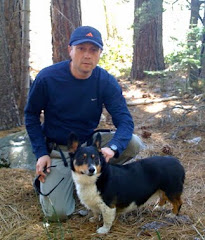 h on history, the importance of dogs, and that bad boy of Renaissance Italy, Cesare Borgia.
h on history, the importance of dogs, and that bad boy of Renaissance Italy, Cesare Borgia.Set in early 16th century Italy during the dangerous reign of the Borgias, SINS OF THE HOUSE OF BORGIA tells the story of Esther, a young Jewess who escapes with her family from Isabel of Castile's Spain, only to find herself enraptured by, and ensnared in, the intrigues and lethal attractions of Cesare Borgia and his sister, Lucrezia. Readers will be enthralled by this mesmerizing tale of an innocent's journey into the dark secret heart of one of Italy's most infamous papal dynasties.
One Man and His Dog
by Sarah Bower
by Sarah Bower
In the beginning of the Powell and Pressburger film A Matter of Life and Death (1946), a wartime airman is washed up on a beach after his aircraft is shot down over the sea. He believes he is dead and has gone to heaven. As he walks up the beach, he encounters a black Labrador.
‘I always hoped there’d be dogs,’ he says as he pats the animal’s head.
The room where I write contains two desks, two computers, an inexplicably large number of books (do they breed, I wonder, while my back is turned? Should I worry about leaving my Freud next to my Austen..?), and two golden retrievers. These retrievers – Clarence and Floyd (named after two characters from the same movie) – are apparently inert. To the uninitiated they might seem to be rugs, moth-eaten leftovers from a golden age of big game hunting, or possibly evidence of a bizarre taste for taxidermy. Yet despite the fact that they sleep away my working hours, only snapping into a flurry of dancing, whimpering and tail wagging when I rise from my desk and intone the word, ‘walk’, or possibly, ‘tea’, they make an invaluable contribution to my fiction.Walking is itself a great spur to creativity, of course. Keats, it is said, composed verses in his head while walking on Hampstead Heath and committed them, fully formed, to paper when he arrived home.
He took
In his knapsack
A book
Full of vowels
And a shirt
With some towels –(From John Keats, A Song About Myself: The Complete Poems, Penguin Classics 3rd edition 1988)
You can almost hear the rhythm of his feet, can’t you? History does not relate ( I don’t think) if he walked with a dog, but I’m certain many authors do. Among the many memorable characters in J. G. Farrell’s novel, The Singapore Grip, set in the period just before the fall of Singapore to the Japanese in 1942, is a mangy, half-blind King Charles spaniel, nicknamed The Human Condition. The Human Condition survives bombing and shelling, several attempts to take him to the vet to be put down, and beats most of the human characters on to the last ship away from the island before the invading force arrives. He left me suspecting that Farrell, like me, wrote in the presence of dogs.
The decision to give Bishop Odo in The Needle in the Blood a favourite dog was straightforward. One of the themes of that book is – perversely – the Englishness of the Normans, the fact that William the Conqueror and those who accompanied him on his great adventure are as much the ancestors of P. G. Wodehouse’s Lord Emsworth as they are the proto-Nazis much beloved of the champions of Harold Godwinson and his Anglo Saxon kingdom. English gentlemen – just like Powell and Pressburger’s gallant bomber pilot, played by that quintessential English actor, David Niven – have dogs. Much as J. G. Farrell’s lamentable King Charles spaniel acquired his Human Condition, however, I found that Bishop Odo’s dog, Juno, developed a role and character of her own and began to make interventions in the narrative as a kind of interpreter of human emotions, a channel of communication between human characters bent on misunderstanding one another.
So, by the time I came to plan my latest book, Sins of the House of Borgia, which looks at the lives of Cesare and Lucrezia Borgia through the eyes of a young Jewish conversa, I was very conscious of the need to add dogs to the mix. There are two dogs of importance in the book - Alfonsino, a lap dog given to Lucrezia as a betrothal gift by her last husband, Alfonso d’Este, and Tiresias, a blind hound belonging to Cesare. A theme of the novel is doubling: Esther, the Jewess, and Lucrezia are very similar in appearance, a fact which has enormous consequences for Esther. One way in which I chose to signify this was to set up a rapport between Esther and the dog. She becomes its principal carer, and this in turn leads her into certain circumstances which change her life. Lucrezia begins by disliking the dog but shifts towards affection for it as she settles into a marriage which was, if not an idyllic love affair, a long and successful one which eventually enabled her to escape the lurid reputation she had acquired as a girl in Rome. In Ferrara, where the Este were the ruling family, she is remembered with great fondness for her cultivated court and her gallantry in defending the city during the War of the League of Cambrai.
Tiresias was a late addition to the novel. He didn’t appear in the first draft at all and it was only while I was proof reading The Needle in the Blood it occurred to me that Cesare Borgia needed a dog every bit as much as Bishop Odo, perhaps more so, as my initial motivation in giving him Tiresias was quite shamelessly manipulative. I wanted to make my readers like him more. Cesare Borgia has been fictionalised in many ways, from the wonderfully subtle portrayal by Nigel Balchin in The Borgia Testament, in my view the best of all novels about the Borgias, to the wicked and clever comedy of Somerset Maugham’s Then and Now to the gloriously predatory ogre of Gregory Maguire’s Mirror, Mirror. He is a godsend to the novelist in many ways, having led a life which his biographer, Sarah Bradford , describes as having all the ingredients of a Greek tragedy. He is also (and I suspect, wherever he is now, with or without dogs, this must be a source of great satisfaction to him) impossible. As many headed as the hydra that was his emblem, every time you think you’ve got a grasp on his character, he slips away. The atheist son of a Pope, the womaniser who took no account of any woman other than his mother and his sister, possibly the greatest military and political genius of his age who nevertheless ended in complete failure, the inspiration for Machiavelli’s Prince – but then we have to ask ourselves, what is The Prince? Is it a serious treatise on government or a deeply ironical joke levelled at the tyrannical Medici by a dyed-in-the-wool republican?
These contradictions, the evasiveness and trickery of the man even 500 years beyond the grave (he died in 1507), challenges the novelist to transform him into either hero or villain with any conviction. He forces her to do what, of course, she should be doing, to recreate out of the facts and the myths an authentic human being. All human beings have their loveable side, even if only their own mothers can see it. Unfortunately, my plot dictated that Cesare’s relationship with his mother would not show his best side. If we’re lucky, we get unconditional love from our mothers, but everyone gets unconditional love from their dog. How better to show Cesare to advantage than by giving him a dog? Of course, like any other gentleman of his age, he would have owned a lot of dogs, hounds of various kinds for hunting (though hunting with leopards was one of his favourite pastimes – how wonderfully over-the-top Renaissance of him) and would have put considerable resources into breeding them. What, then, would he do with a puppy born blind? Well, have it destroyed, of course.
An exercise I often set my students is to turn a convention on its head and see where it takes you. What, for example, happens to the story if you turn Cinderella into a boy or give Don Juan a conscience? With Tiresias, I did exactly the same thing – instead of putting him down, Cesare keeps him. He says it’s because, being blind, he will have a good nose for truffles, but you kind of know that’s just an excuse, a pragmatic front put up to shield the sentimental streak in his nature. So, Tiresias stands for the goodness in Cesare, for the side of him that is capable of love and loyalty and straight dealing. His lifespan is also exactly that of the papacy of Alexander VI, Cesare’s father, and thus, by his untimely, violent and avoidable death, he foreshadows his master’s own end. Oh, and he gives Cesare the idea for the chestnut orgy. Chestnut orgy? Well, if you want to know more, you’ll have to read Sins of the House of Borgia, which explores many different kinds of love, not least that of a man for his dog and vice versa.
Sarah Bower is the author of two historical novels. The Needle in the Blood was Susan Hill’s Book of the Year 2007. The Sins of the House of Borgia, first published as Book of Love, is now released in the US in trade paperback from SourceBooks. Thank you, Sarah. We wish you much success in your latest US debut!













6 comments:
What a fabulous guest post, thank you for posting this again Christopher! I am reading Sins right now and thoroughly enjoying it. I am a huge dog lover and always love with an author writes them into the story!
Loved the guest post, this comment caught my attention "So, Tiresias stands for the goodness in Cesare, for the side of him that is capable of love and loyalty and straight dealing." ... *sigh* very keen to read Sins of the House of Borgia, onto my wishlist it goes :)
So glad to hear you're enjoying it, Amy; I love books with dogs (and leopards) too! Teddy, this is a must read. Truly, a gorgeous novel.
Christopher, you're too kind :)
They either went to Heaven or Hell. He knew there was someone else in the chamber with him.
Zetaclear
Great post, I'll have to read that now. I was debating but now the decision has been made for me! If you guys are fans of sins another great book about a renaissance bad boy you might like is Scimitar: http://www.scimitarthebook.com/
Post a Comment